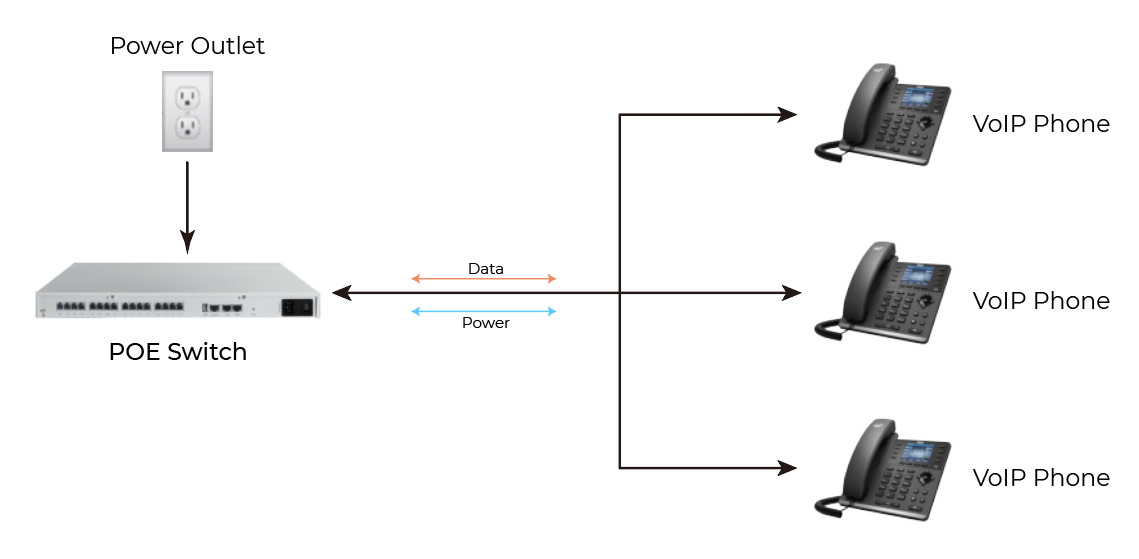Healthcare
Elevating Patient Care Through Intelligent Technology
If you are building the network infrastructure, you need a suitable way to power and transmit data to your network device. Then you may run into the choice between PoE and PoE+. The decision on which one to choose can make a difference in network performance, costs, and energy efficiency. This article will explore the two technologies to help you make a better choice that best fits your needs.
What Is PoE?
Power over Ethernet (PoE) refers to supplying power through an Ethernet network. It enables the transmission of electric current and data simultaneously through Ethernet cables, eliminating the need for separate power cables. This technology was defined by the IEEE 802.3af standard in 2003.
What is a PoE switch? PoE switch is an application of PoE technology. Functioning as a kind of PSE (power sourcing equipment), a PoE switch can supply power to PD (powered device)s via Ethernet cables to realize network connectivity. 1
Migelle, FS.com. “PoE vs PoE+ vs PoE++ Switch: How to Choose?". Mar 16, 2023, https://community.fs.com/blog/poe-switch-types.html

For a PoE switch, the power supply port voltage is between 44V-57V, with a max power consumption of up to 15.4W; the terminal equipment port voltage range is between 37V-57V, and the power reaches 12.95W. This generation of PoE technology is called Type 1 PoE.
PoE Applications:
Being capable of providing sufficient power for most wireless access points(WAPs), security cameras, IP phones, and indoor audio-visual equipment, PoE is suitable for applications without AC power supply access.
What is PoE+?
PoE+ technology (IEEE 802.3at standard) is an enhanced version of PoE, which provides higher power delivery capabilities for greater flexibility and expanded device support.
The power supply voltage of the PoE+ switch port is between 50V-57V, and the power reaches 30W; the terminal equipment port voltage range is between 42.5V-57V, and the power reaches 25.5W. This generation of PoE technology is called Type 2 PoE.
PoE+ applications:
PoE+ switch is often used in applications to provide more power and higher speed data communication for connected devices. It can be used in office or home alarm systems, remotely managed PTZ cameras, biometric sensors, RFID readers, motion tracking cameras installed in commercial premises, remote computer terminals, and IP telephones for voice calls, text messaging, and fax.
Comparison between PoE vs PoE+
After knowing about the details of PoE and PoE+, the following are some significant differences between them:
The IEEE standard for the PoE switches is 802.3af; 802.3at for PoE+.
The maximum power provided per port is different. PoE switch can provide 12.95W-15.4W of power per port, and PoE+ switch provides 25.5W-30W of power per port.
To make it clear, a reference table that summarizes detailed specifications among PoE vs PoE+ switches is presented below.
| PoE | PoE+ | |
|
IEEE Standard |
802.3af |
802.3at |
| PoE Type | Type 1 | Type 2 |
|
Switch Port Power |
||
|
Maximum Power Per Port |
15.4W |
30W |
|
Port Voltage Range |
44-57V |
50-57V |
|
Powered Device Power |
||
|
Maximum Power to Device |
12.95W |
25.5W |
|
Voltage Range to Device |
37-57V |
42.5-57V |
| Cables | ||
|
Twisted Pairs Used |
2-pair |
2-pair |
|
Supported Cable Types |
Cat3 or better |
Cat5 or better |
As we can see from the instructions above, PoE+ has the following advantages over PoE:
1. Higher power: PoE can provide 15.4 watts over Cat3 cables, while PoE+ can supply up to 30W over Cat5 cables, with 25.5W available to devices.
2. Stronger compatibility: PoE+ PSEs can supply power to both PoE and PoE+ PDs, while PoE PSEs can only supply power to PoE PDs.
3. Further cost reduction: The PoE+ uses standard cabling (Cat5) to work with ordinary Ethernet interfaces, with no "new wire" requirement.
4. More powerful: PoE+ uses Cat5 network cable, which has 8 internal wires, which reduces the possibility of impedance and power consumption. Additionally, PoE+ allows network administrators to provide greater functionality, such as providing new remote power diagnostics, status reporting, and power supply management.
Based on the instructions mentioned above, you may understand the differences between PoE vs. PoE+ and you can make a better choice between them. Zycoo provides clients with Unified IP Audio Solutions and products with PoE or PoE+ support, which allows high performance as well as easy installation.